Micron C400 mSATA (128GB) SSD Review
by Anand Lal Shimpi on April 10, 2012 8:00 AM ESTAnandTech Storage Bench 2011
Two years ago we introduced our AnandTech Storage Bench, a suite of benchmarks that took traces of real OS/application usage and played them back in a repeatable manner. I assembled the traces myself out of frustration with the majority of what we have today in terms of SSD benchmarks.
Although the AnandTech Storage Bench tests did a good job of characterizing SSD performance, they weren't stressful enough. All of the tests performed less than 10GB of reads/writes and typically involved only 4GB of writes specifically. That's not even enough exceed the spare area on most SSDs. Most canned SSD benchmarks don't even come close to writing a single gigabyte of data, but that doesn't mean that simply writing 4GB is acceptable.
Originally I kept the benchmarks short enough that they wouldn't be a burden to run (~30 minutes) but long enough that they were representative of what a power user might do with their system.
Not too long ago I tweeted that I had created what I referred to as the Mother of All SSD Benchmarks (MOASB). Rather than only writing 4GB of data to the drive, this benchmark writes 106.32GB. It's the load you'd put on a drive after nearly two weeks of constant usage. And it takes a *long* time to run.
1) The MOASB, officially called AnandTech Storage Bench 2011 - Heavy Workload, mainly focuses on the times when your I/O activity is the highest. There is a lot of downloading and application installing that happens during the course of this test. My thinking was that it's during application installs, file copies, downloading and multitasking with all of this that you can really notice performance differences between drives.
2) I tried to cover as many bases as possible with the software I incorporated into this test. There's a lot of photo editing in Photoshop, HTML editing in Dreamweaver, web browsing, game playing/level loading (Starcraft II & WoW are both a part of the test) as well as general use stuff (application installing, virus scanning). I included a large amount of email downloading, document creation and editing as well. To top it all off I even use Visual Studio 2008 to build Chromium during the test.
The test has 2,168,893 read operations and 1,783,447 write operations. The IO breakdown is as follows:
| AnandTech Storage Bench 2011 - Heavy Workload IO Breakdown | ||||
| IO Size | % of Total | |||
| 4KB | 28% | |||
| 16KB | 10% | |||
| 32KB | 10% | |||
| 64KB | 4% | |||
Only 42% of all operations are sequential, the rest range from pseudo to fully random (with most falling in the pseudo-random category). Average queue depth is 4.625 IOs, with 59% of operations taking place in an IO queue of 1.
Many of you have asked for a better way to really characterize performance. Simply looking at IOPS doesn't really say much. As a result I'm going to be presenting Storage Bench 2011 data in a slightly different way. We'll have performance represented as Average MB/s, with higher numbers being better. At the same time I'll be reporting how long the SSD was busy while running this test. These disk busy graphs will show you exactly how much time was shaved off by using a faster drive vs. a slower one during the course of this test. Finally, I will also break out performance into reads, writes and combined. The reason I do this is to help balance out the fact that this test is unusually write intensive, which can often hide the benefits of a drive with good read performance.
There's also a new light workload for 2011. This is a far more reasonable, typical every day use case benchmark. Lots of web browsing, photo editing (but with a greater focus on photo consumption), video playback as well as some application installs and gaming. This test isn't nearly as write intensive as the MOASB but it's still multiple times more write intensive than what we were running in 2010.
As always I don't believe that these two benchmarks alone are enough to characterize the performance of a drive, but hopefully along with the rest of our tests they will help provide a better idea.
The testbed for Storage Bench 2011 has changed as well. We're now using a Sandy Bridge platform with full 6Gbps support for these tests.
AnandTech Storage Bench 2011 - Heavy Workload
We'll start out by looking at average data rate throughout our heavy workload test:
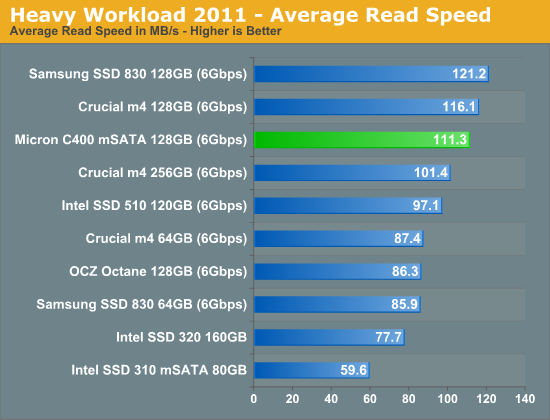
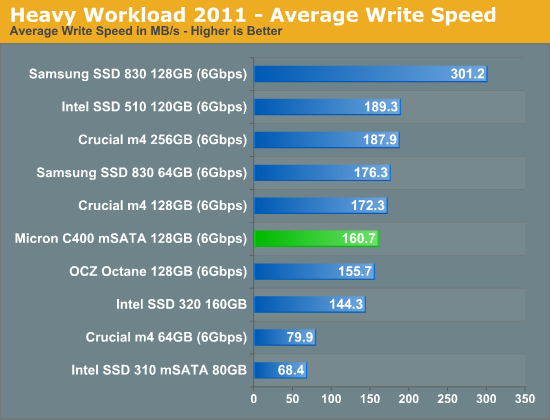
The next three charts just represent the same data, but in a different manner. Instead of looking at average data rate, we're looking at how long the disk was busy for during this entire test. Note that disk busy time excludes any and all idles, this is just how long the SSD was busy doing something:
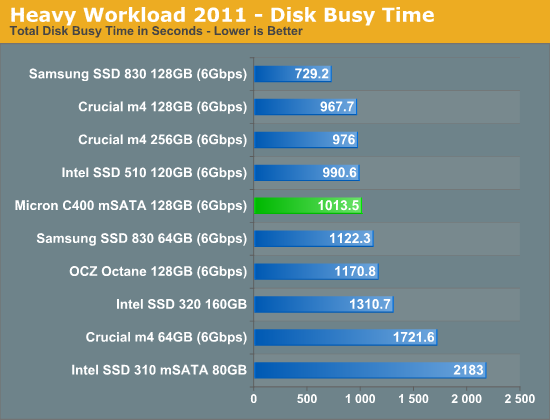

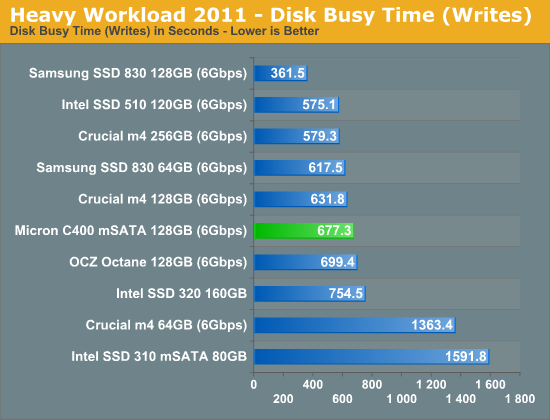


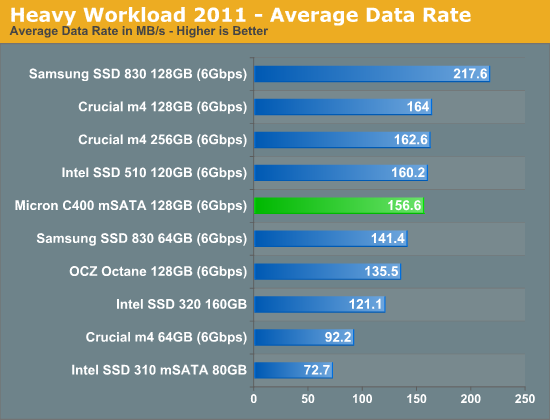








47 Comments
View All Comments
GreenEnergy - Tuesday, April 10, 2012 - link
"Micron does not disclose its OEM pricing structure, but a company rep told us that the mSATA version of the C400 would cost a little bit less than the standard SATA versions that are available today."I could do with a 256GB mSATA SSD only in the mSATA/mPCIe slot. If I didnt own a 300GB SSD 320 series already....
Its just amazing to see. Tiny and powerful.
skildner - Tuesday, April 10, 2012 - link
If this is actually less than their current lineup of standard SATA versions, that would be amazing. There are a number of good mSATA drives out there, but prices haven't dropped like the standard SATA drives. The Runcore mSATA III would be my pick as it destroys all other mSATA drives, but it's about $2.50/gb. I would really take any second gen mSATA drive though as long as it hovered in the $1/gb range. The OCZ Nocti currently has the best price/performance and is around $1.50/gb.DanNeely - Tuesday, April 10, 2012 - link
I suppose the real question is if they're loss-leadering it to build market share, or if the smaller package actually is meaningfully cheaper to produce.GreenEnergy - Tuesday, April 10, 2012 - link
Its essentially the same package inside the bigger 2½" SSD. So saving a few $ on casing and such adds to it. But note they said a little bit.klmccaughey - Tuesday, April 10, 2012 - link
My mobo only has SATA 2 on the mSata port, and a quick look around it seems this is pretty standard.Is it still worth it? I already have 2x Vertex 3 128GB, one as C drive and the other as a games drive, but I would love to have a cache as well for my 1TB HD (where most of 250 games from Steam are /juntioned.
iwod - Tuesday, April 10, 2012 - link
Now i really hope Apple would adopt the Marvell controller, or even its next gen controller instead of using Samsung or Toshiba...Drizzt321 - Tuesday, April 10, 2012 - link
Any clue what the availability is? I've been wanting to put an mSATA as my primary OS for a while, but they seem to top out at 120GB for the OCZ Octi right now, but I really want more. Too bad my notebook only does SATA2 over mSATA :\Hubb1e - Tuesday, April 10, 2012 - link
My Gigabyte board as a mSATA port on it but is limited to 3gb. Is there any performance penalty for going with a 3Gb port? This form facter on a Gigabyte board would be an extremely clean system and is a great way to save some cabling mess in a case but it's not worth it if it's going to be slower.frostyfiredude - Tuesday, April 10, 2012 - link
Essentially what will happen is the data transfer between your motherboard and SSD will be capped at ~300MB/s. So look though the charts, you will only notice a difference between a 3Gb/s and 6Gb/s port in the loads that allow the drive to push past that ~300MB/s. For this C400/M4 SSD the only time that port difference will be relevant is during sequential reads.So my take is to not be concerned unless you absolutely need to maximize the performance of sequential reads, because all other aspects of the SSDs performance won't be affected at all. Most desktop loads are fairly random, so I doubt you'll notice a difference in normal use.
For what it's worth, I have a Corsair Force3GT plugged into a 3Gb/s port and it still feels the tiniest amount faster than my parents Crucial M4 which is plugged into a 6Gb/s port.
GreenEnergy - Tuesday, April 10, 2012 - link
Also raw sequal bandwidth doesnt make SSD fast. Random I/O does aswell as the seektime.And in 95% of all I/O operations are random I/O. And you get on a good day 50-100MB/sec there.